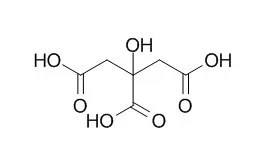Several bioassays were conducted with young chicks and pigs fed phosphorus (P)-deficient corn-soybean meal diets.
METHODS AND RESULTS:
With diets for chicks containing .62% Ca and .42% P (.10% available P), graded doses of a Citric acid + sodium citrate (1:1, wt:wt) mixture (0, 1, 2, 4, or 6% of diet) resulted in linear (P < .01) increases in both weight gain and tibia ash. Relative to chicks fed no Citric acid, tibia ash (%) and weight gain (g/d) were increased by 43 and 22%, respectively, in chicks fed 6% Citric acid. Additional chick trials showed that 6% Citric acid alone or sodium citrate alone was as efficacious as the Citric acid + sodium citrate mixture and that 1,450 U/kg of phytase produced a positive response in bone ash and weight gain in chicks fed a diet containing 6% citrate. Varying the Ca:available P ratio with and without citrate supplementation indicated that Citric acid primarily affected phytate-P utilization, not Ca, in chicks. Moreover, chicks did not respond to citrate supplementation when fed a P-deficient (.13% available P), phytate-free casein-dextrose diet. Young pigs averaging 10 to 11 kg also were used to evaluate Citric acid efficacy in two experiments. A P-deficient corn-soybean meal basal diet was used to construct five treatment diets that contained 1) no additive, 2) 3% Citric acid, 3) 6% Citric acid, 4) 1,450 U/kg phytase, and 5) 6% Citric acid + 1,450 U/kg phytase. Phytase supplementation increased (P < .01) weight gain, gain:feed, and metatarsal ash, whereas Citric acid addition increased only gain:feed (P < .05) and metatarsal ash (P < .08). A subsequent 22-d pig experiment was conducted to evaluate the effect of lower levels of Citric acid (0, 1, 2, or 3%) or 1,450 U/kg phytase addition to a P-deficient corn-soybean meal diet. Phytase supplementation improved (P < .01) all criteria measured. Weight gain and gain:feed data suggested a response to Citric acid addition, but this was not supported by fibula ash results (P > .10). The positive responses to phytase were much greater than those to Citric acid in both pig experiments.
CONCLUSIONS:
Thus, dietary Citric acid effectively improved phytate P utilization in chicks but had a much smaller effect in pigs. |






 Cell. 2018 Jan 11;172(1-2):249-261.e12. doi: 10.1016/j.cell.2017.12.019.IF=36.216(2019)
Cell. 2018 Jan 11;172(1-2):249-261.e12. doi: 10.1016/j.cell.2017.12.019.IF=36.216(2019) Cell Metab. 2020 Mar 3;31(3):534-548.e5. doi: 10.1016/j.cmet.2020.01.002.IF=22.415(2019)
Cell Metab. 2020 Mar 3;31(3):534-548.e5. doi: 10.1016/j.cmet.2020.01.002.IF=22.415(2019) Mol Cell. 2017 Nov 16;68(4):673-685.e6. doi: 10.1016/j.molcel.2017.10.022.IF=14.548(2019)
Mol Cell. 2017 Nov 16;68(4):673-685.e6. doi: 10.1016/j.molcel.2017.10.022.IF=14.548(2019)